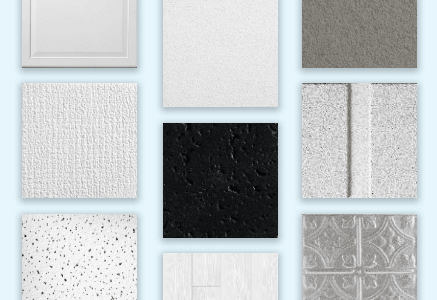Water stains on ceiling: Here's how to fix water damage on ceilings

Water stains on ceilings can be more than just an eye sore. They often signal a larger issue like a roof leak, pipe problem, or condensation buildup. If you’re noticing brown spots, sagging ceiling tiles, or peeling paint, you should act quickly before the problem gets worse.
This comprehensive guide walks you through:
-
Identifying the source of water stains
-
Assessing the severity of damage
-
Deciding whether to repair or replace
-
Guiding you with step-by-step instructions for DIY ceiling repair
-
Preventing future water damage
Let’s get started.
What causes water stains on ceilings?
Water stains are most commonly caused by:
-
Roof leaks: Missing shingles, worn flashing, or ice dams
-
Plumbing leaks: Burst or dripping pipes above the ceiling
-
HVAC condensation: Especially common in humid climates
-
Overflowing appliances: Such as toilets, bathtubs, or dishwashers on upper floors
Water typically seeps into the ceiling and leaves behind a brown or yellowish ring. Over time, the area can darken, sag, or even crack and crumble.

Step by step guide for how to fix water damage on ceilings
Step 1: Identify and fix the source
Before any cosmetic repairs, you need to find and fix the root cause.
-
Check for roof leaks during or after rainfall
-
Inspect plumbing for drips or moisture around pipes
-
Monitor HVAC units for condensation issues
Until the source of water is stopped, repairing the ceiling is only a temporary fix.
Step 2: Assess the damage
Once the leak is resolved, assess how bad the damage is to the ceiling.
-
Stained but dry? The ceiling may only need cosmetic repair
-
Sagging or soft? The materials likely need to be replaced
-
Moldy or mildewed? You’ll need to disinfect and possibly replace the area
Materials affected may include:
-
Drywall
-
Ceiling tiles
-
Plaster
Step 3: Repair or replace ceiling?
Repair if the stain is minor and the structure is sound
If the water stain is small, you don’t find mold, and the ceiling tile or drywall is still intact and dry, you can often get by with a simple repair.
For ceiling tiles with surface stains, you can:
-
Clean the stain: Use a mixture of water and mild detergent or a solution of bleach and water (1 part bleach to 3 parts water) to lighten or remove the discoloration. Always test a small area first.
-
Apply stain blocking primer: Once fully dry, apply a stain-blocking primer to prevent the stain from bleeding through again.
-
Repaint the surface: Use ceiling paint that matches the rest of the surface or repaint the entire tile for uniformity.
-
Patch & match: If you’re working with drop ceiling tiles, you can easily replace your tiles with fresh ones. Find your ceiling match
Important: If you're unsure about the extent of the damage or suspect underlying issues, it's best to consult a professional to assess the structure and ensure safety before proceeding with any repairs.
Replace if the area is large, mold is present, or if there is structural damage
If the stained area is large, sagging, soft to the touch, or structurally compromised, repair isn’t enough. You’ll need to:
-
Remove the damaged ceiling tile or drywall: Carefully take out the affected area to inspect for underlying issues like leaks or wood rot.
-
Fix the source of the damage: Before replacing any ceiling materials, confirm the source of the water leak is fixed.
-
Install new material: For suspended ceilings, replace stained or warped ceiling tiles with new ones designed for moisture resistance and easy maintenance.
Step 4: Prevent future water damage
-
Maintain your roof: Inspect twice a year and after storms
-
Insulate pipes: Prevent freezing and bursting
-
Install dehumidifiers: Reduce moisture in high-humidity areas
-
Seal your attic: Prevent condensation and ice dams
-
Upgrade your ceiling tiles: Kanopi by Armstrong World Industries™ offers moisture-resistant options
Where to find replacement ceiling tiles?
When it’s time to replace damaged or outdated ceiling tiles, Kanopi makes the process simple and stress free. We offer a wide selection of high-quality replacement ceiling tiles that are:
-
Easy to install: Perfect for quick fixes or full ceiling upgrades.
-
Mold and mildew resistant: Designed to improve indoor air quality and maintain a healthier space.
-
Available in a variety of designs and textures: Match your existing look or refresh your style entirely.
-
Delivered right to your door: Convenient shipping so you can get back to normal with a better space.
Whether you're dealing with water damage, stains, or general wear and tear, replacing your ceiling tiles can instantly revive your space in appearance and performance. Explore our full collection online and find the right fit for your home or commercial space with ease. Shop ceilings
Areas more prone to ceiling water stains
Certain regions across the United States face a higher risk of water stains on ceilings due to frequent storms, high humidity, heavy snowfall, or older building infrastructure. Homeowners and property managers in these areas should be especially proactive with ceiling inspections and maintenance:
-
Gulf Coast (e.g., Florida, Louisiana, Texas): Prone to hurricanes, tropical storms, and year round humidity, making buildings more susceptible to roof leaks and mold growth.
-
Northeast (e.g., New York, Massachusetts, Pennsylvania): Aging buildings combined with heavy winter snow and ice storms can cause hidden roof leaks and water damage.
-
Pacific Northwest (e.g., Washington, Oregon): Known for extended rainy seasons that increase the risk of moisture intrusion and ceiling discoloration.
-
Midwest (e.g., Illinois, Ohio, Michigan): Snow accumulation and springtime thawing often lead to roof stress and water seepage, especially in older homes.
-
Southeast (e.g., Georgia, South Carolina, North Carolina): High humidity levels and seasonal storms contribute to gradual ceiling deterioration if not properly ventilated or maintained.
No matter where you live, early detection and routine ceiling checks can prevent costly repairs. If you notice persistent stains or signs of sagging, it's important to consult a professional to identify the root cause.
Final thoughts
Water stains on ceilings aren’t something you should ignore. Quick action can save you money, prevent mold growth, and maintain your property’s value. Whether it’s a quick repaint or a full ceiling tile replacement, Kanopi has you covered with high-quality, easy-to-install products.
FAQs
What causes water stains on ceilings?
Typically, it’s due to roof leaks, plumbing issues, or condensation from HVAC systems.
How do I know if there is mold?
Look for black or green spots and a musty smell. When in doubt, consult a professional.
What kind of ceiling tiles resist moisture?
Look for mold and mildew resistant ceiling tiles, browse moisture resistant tiles
Is it expensive to repair ceiling water damage?
Costs vary, but minor repairs are usually inexpensive. Replacing ceiling tiles is often cost-effective..
Can I install new ceiling tiles myself?
Yes, especially with Kanopi’s drop ceiling tiles designed for easy DIY installation.



 Thanks for subscribing!
Thanks for subscribing!